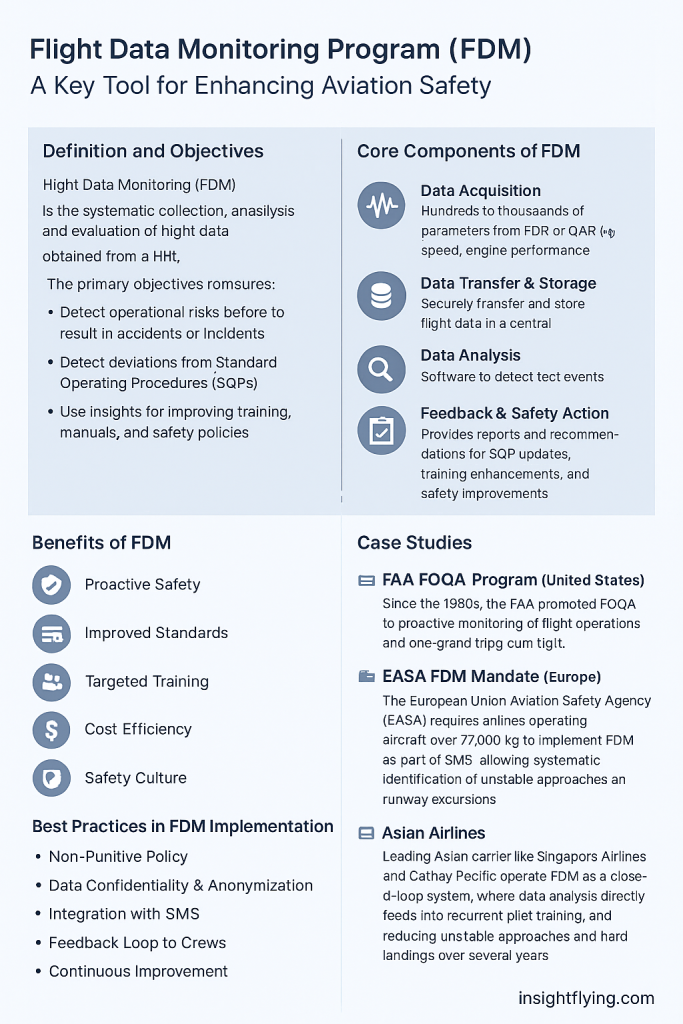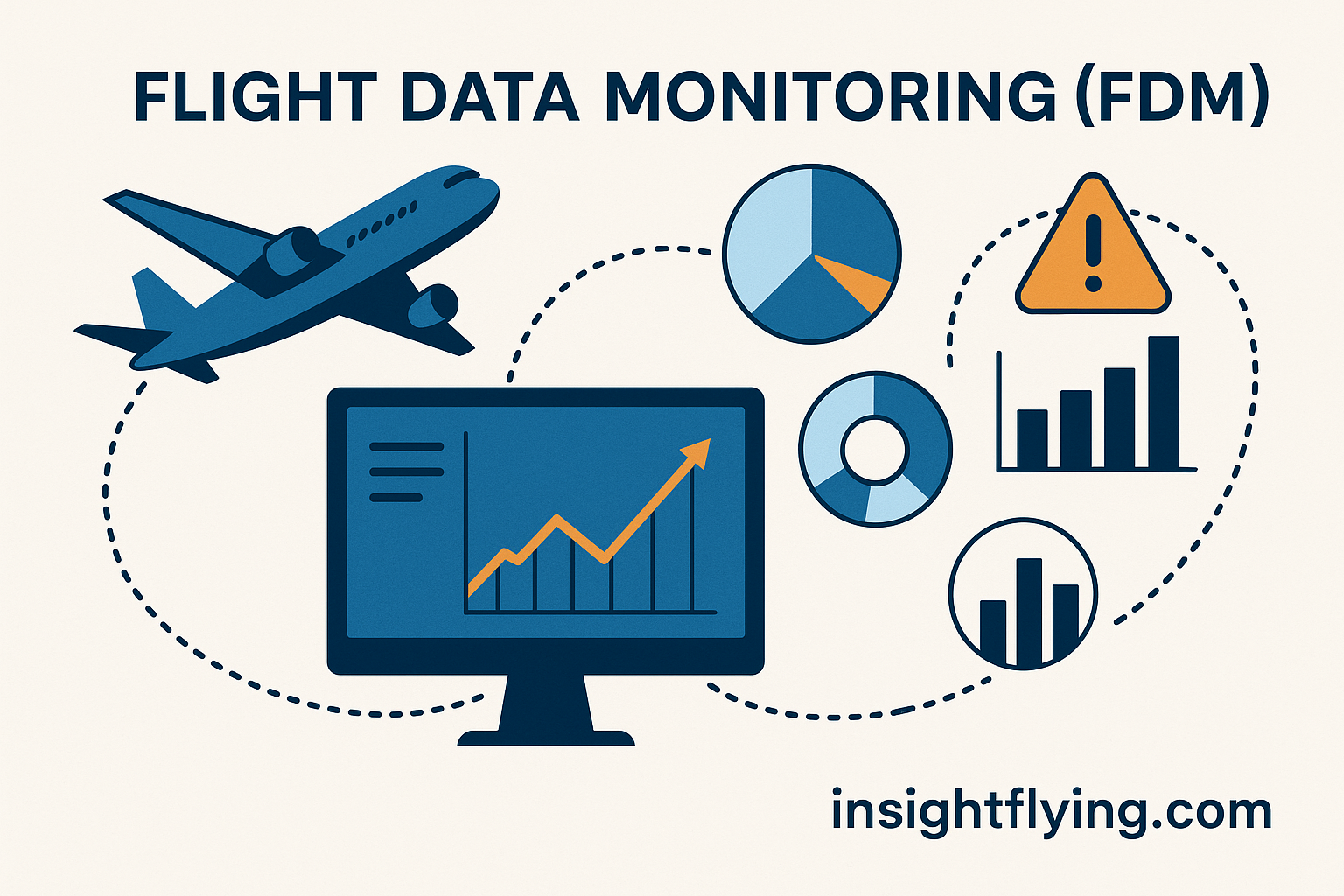บทนำ
การบินพาณิชย์ในปัจจุบันมีความซับซ้อนและเต็มไปด้วยความท้าทายต่อความปลอดภัยของเที่ยวบิน องค์การการบินพลเรือนระหว่างประเทศ (ICAO) และหน่วยงานกำกับดูแลด้านการบินของแต่ละประเทศ ต่างให้ความสำคัญกับการพัฒนา ระบบการจัดการความปลอดภัย (Safety Management System: SMS) ซึ่งหนึ่งในเครื่องมือสำคัญที่ช่วยสนับสนุนการทำงานของ SMS คือ Flight Data Monitoring Program (FDM) หรือที่บางครั้งเรียกว่า Flight Operations Quality Assurance (FOQA)
ความหมายและวัตถุประสงค์
Flight Data Monitoring (FDM) คือ กระบวนการเก็บรวบรวม วิเคราะห์ และประเมินข้อมูลการบินที่ได้จาก Flight Data Recorder (FDR) หรืออุปกรณ์บันทึกการบินอื่น ๆ โดยมีเป้าหมายหลักเพื่อ
- เฝ้าระวังแนวโน้มที่อาจนำไปสู่ความเสี่ยงด้านความปลอดภัย
- ตรวจจับพฤติกรรมการปฏิบัติการบินที่อาจเบี่ยงเบนจากมาตรฐาน (Standard Operating Procedures: SOPs)
- นำข้อมูลเชิงลึกมาปรับปรุงการฝึกอบรม การจัดทำคู่มือ และนโยบายความปลอดภัยของสายการบิน
องค์ประกอบหลักของ FDM
- Data Acquisition – การเก็บข้อมูลจาก Flight Data Recorder หรือ Quick Access Recorder (QAR)
- Data Transfer & Storage – การถ่ายโอนและเก็บรักษาข้อมูลในฐานข้อมูลกลาง
- Data Analysis – การวิเคราะห์เพื่อตรวจจับเหตุการณ์ที่เป็นความเสี่ยง เช่น Hard Landing, Unstable Approach, Tail Strike
- Feedback & Safety Action – การนำผลการวิเคราะห์มาใช้ปรับปรุง SOP, การฝึกอบรม และนโยบายความปลอดภัย
ประโยชน์ของ Flight Data Monitoring Program
- เชิงป้องกัน (Proactive Safety): ตรวจจับแนวโน้มก่อนที่จะเกิดอุบัติเหตุ
- การปรับปรุงมาตรฐานการบิน: ยกระดับคุณภาพของ SOP
- การฝึกอบรมที่ตรงจุด: ใช้ข้อมูลจริงเพื่อปรับปรุงการฝึกนักบิน
- การจัดการต้นทุน: ลดค่าใช้จ่ายจากเหตุการณ์ไม่พึงประสงค์
- การสร้างวัฒนธรรมความปลอดภัย: ส่งเสริมความตระหนักรู้ของนักบินและบุคลากร
กรณีศึกษา (Case Studies)
1. FAA FOQA Program (สหรัฐอเมริกา)
ในสหรัฐอเมริกา FAA ส่งเสริมให้สายการบินนำ FOQA (Flight Operations Quality Assurance) มาใช้ตั้งแต่ช่วงปี 1990 โดยเน้นให้ข้อมูลถูกใช้เพื่อ วิเคราะห์เชิงป้องกัน ไม่ใช่เชิงลงโทษ ตัวอย่างคือ การตรวจพบว่า “High-energy approaches” เกิดขึ้นบ่อยกว่าที่คาดการณ์ไว้ จึงนำผลมาปรับปรุงการฝึกใน simulator และ SOP ทำให้จำนวนเหตุการณ์ลดลงได้อย่างชัดเจน
2. EASA Flight Data Monitoring (ยุโรป)
EASA กำหนดให้สายการบินที่มีน้ำหนักเครื่องเกิน 27,000 กิโลกรัม ต้องมี FDM เป็นส่วนหนึ่งของ SMS ผลที่เกิดขึ้นคือสายการบินยุโรปจำนวนมากสามารถตรวจจับเหตุการณ์ Unstable Approach และ Tail Strike ล่วงหน้า และใช้ข้อมูลเพื่อพัฒนา Runway Safety Program ที่มีประสิทธิภาพสูง
3. สายการบินเอเชีย
สายการบินชั้นนำในเอเชีย เช่น Singapore Airlines และ Cathay Pacific ใช้ FDM เป็น “Closed-loop system” โดยมีขั้นตอนเก็บข้อมูล วิเคราะห์ และนำกลับมาใช้ใน recurrent training ของนักบิน ผลที่ได้คือจำนวน hard landing และ unstabilized approach ลดลงต่อเนื่องหลายปี
Best Practices ของการนำ FDM มาใช้
- Non-Punitive Policy
การปกป้องนักบินจากการถูกลงโทษเป็นหัวใจสำคัญ เพราะหากนักบินไม่มั่นใจว่าข้อมูลจะถูกใช้เพื่อความปลอดภัยเท่านั้น จะทำให้โครงการ FDM ไม่ได้รับความร่วมมือ - Data Confidentiality & Anonymization
ข้อมูลต้องถูกปกปิดหรือนิรนาม เพื่อให้การวิเคราะห์มุ่งเน้นที่ “ระบบและพฤติกรรมการปฏิบัติ” มากกว่าบุคคล - Integration with SMS
FDM ควรถูกเชื่อมโยงกับ SMS โดยตรง เพื่อให้การวิเคราะห์นำไปสู่การปรับปรุงมาตรการความปลอดภัยในระดับองค์กร - Feedback Loop to Crews
นักบินควรได้รับรายงานหรือ bulletin ที่สรุปแนวโน้มเหตุการณ์ (โดยไม่ระบุชื่อบุคคล) เพื่อช่วยสร้างความตระหนักรู้และปรับปรุงการปฏิบัติจริง - Continuous Improvement
สายการบินที่ประสบความสำเร็จในการใช้ FDM มักจะใช้แนวทาง “monitor–analyze–act–review” อย่างต่อเนื่อง เพื่อให้โปรแกรมไม่หยุดนิ่ง แต่ปรับตัวตามสถานการณ์การบินที่เปลี่ยนแปลง
สรุป
Flight Data Monitoring Program (FDM) เป็นเครื่องมือเชิงรุกที่ช่วยยกระดับความปลอดภัยการบินพาณิชย์ โดยมีบทเรียนจากสายการบินทั่วโลกที่ยืนยันว่า FDM สามารถลดความเสี่ยงได้จริง หากดำเนินการภายใต้ นโยบายที่ไม่ลงโทษ (Non-punitive), การคุ้มครองข้อมูล, และการบูรณาการเข้ากับ SMS FDM จะไม่ใช่เพียงเครื่องมือด้านเทคนิค แต่จะเป็นรากฐานของ วัฒนธรรมความปลอดภัย (Safety Culture) ที่มั่นคงของอุตสาหกรรมการบิน

Flight Data Monitoring Program (FDM): A Key Tool for Enhancing Aviation Safety
Introduction
Modern commercial aviation is highly complex and faces constant safety challenges. The International Civil Aviation Organization (ICAO) and national regulators emphasize the development of a Safety Management System (SMS). One of the most effective tools supporting SMS is the Flight Data Monitoring Program (FDM), also known as Flight Operations Quality Assurance (FOQA).
Definition and Objectives
Flight Data Monitoring (FDM) is the systematic collection, analysis, and evaluation of flight data obtained from a Flight Data Recorder (FDR) or Quick Access Recorder (QAR). The primary objectives are:
- To identify operational risks before they result in accidents or incidents.
- To detect deviations from Standard Operating Procedures (SOPs).
- To use insights for improving training, manuals, and safety policies.
Core Components of FDM
- Data Acquisition – Capturing hundreds to thousands of parameters from FDR or QAR (e.g., speed, engine performance, control inputs).
- Data Transfer & Storage – Securely transferring and storing flight data in a central database.
- Data Analysis – Using software to detect “events” such as unstable approaches, high-energy landings, or tail strikes.
- Feedback & Safety Action – Providing reports and recommendations for SOP updates, training enhancements, and safety improvements.
Benefits of FDM
- Proactive Safety: Detects risks before they escalate into accidents.
- Improved Standards: Enhances SOPs and operational manuals.
- Targeted Training: Uses real-world data to refine pilot training.
- Cost Efficiency: Reduces aircraft damage and operational disruptions.
- Safety Culture: Encourages crew awareness and accountability.
Case Studies
1. FAA FOQA Program (United States)
Since the 1990s, the FAA has promoted FOQA to proactively monitor flight operations. For example, airlines discovered that high-energy approaches were more frequent than expected. By integrating this into simulator training and updating SOPs, the occurrence rate was significantly reduced.
2. EASA FDM Mandate (Europe)
The European Union Aviation Safety Agency (EASA) requires airlines operating aircraft over 27,000 kg to implement FDM as part of SMS. This has allowed airlines to systematically identify unstable approaches and runway excursions, supporting the development of effective Runway Safety Programs.
3. Asian Airlines
Leading Asian carriers such as Singapore Airlines and Cathay Pacific operate FDM as a closed-loop system, where data analysis directly feeds into recurrent pilot training. This approach has consistently reduced unstable approaches and hard landings over several years.
Best Practices in FDM Implementation
- Non-Punitive Policy – Ensures data is not used to punish pilots, but to improve safety.
- Data Confidentiality & Anonymization – Protects pilot identity while focusing on systemic issues.
- Integration with SMS – Connects FDM outputs directly with SMS for organizational safety improvements.
- Feedback Loop to Crews – Provides de-identified event bulletins to pilots to raise awareness.
- Continuous Improvement – Uses the “monitor–analyze–act–review” cycle to ensure ongoing effectiveness.
Conclusion
The Flight Data Monitoring Program (FDM) is a proactive safety tool that enables airlines to turn operational data into actionable insights. Real-world case studies confirm that FDM significantly reduces operational risks when implemented under a non-punitive policy, with strong data protection, and full integration into SMS. More than a technical system, FDM is a foundation of a robust safety culture in aviation.
หนังสือการบิน ทางลัดสู่ความเข้าใจที่นำไปใช้งานจริง

|
|

|
|

|
|

|
|

|
|
ขายดีที่สุด

|
|

Leave a Reply
You must be logged in to post a comment.